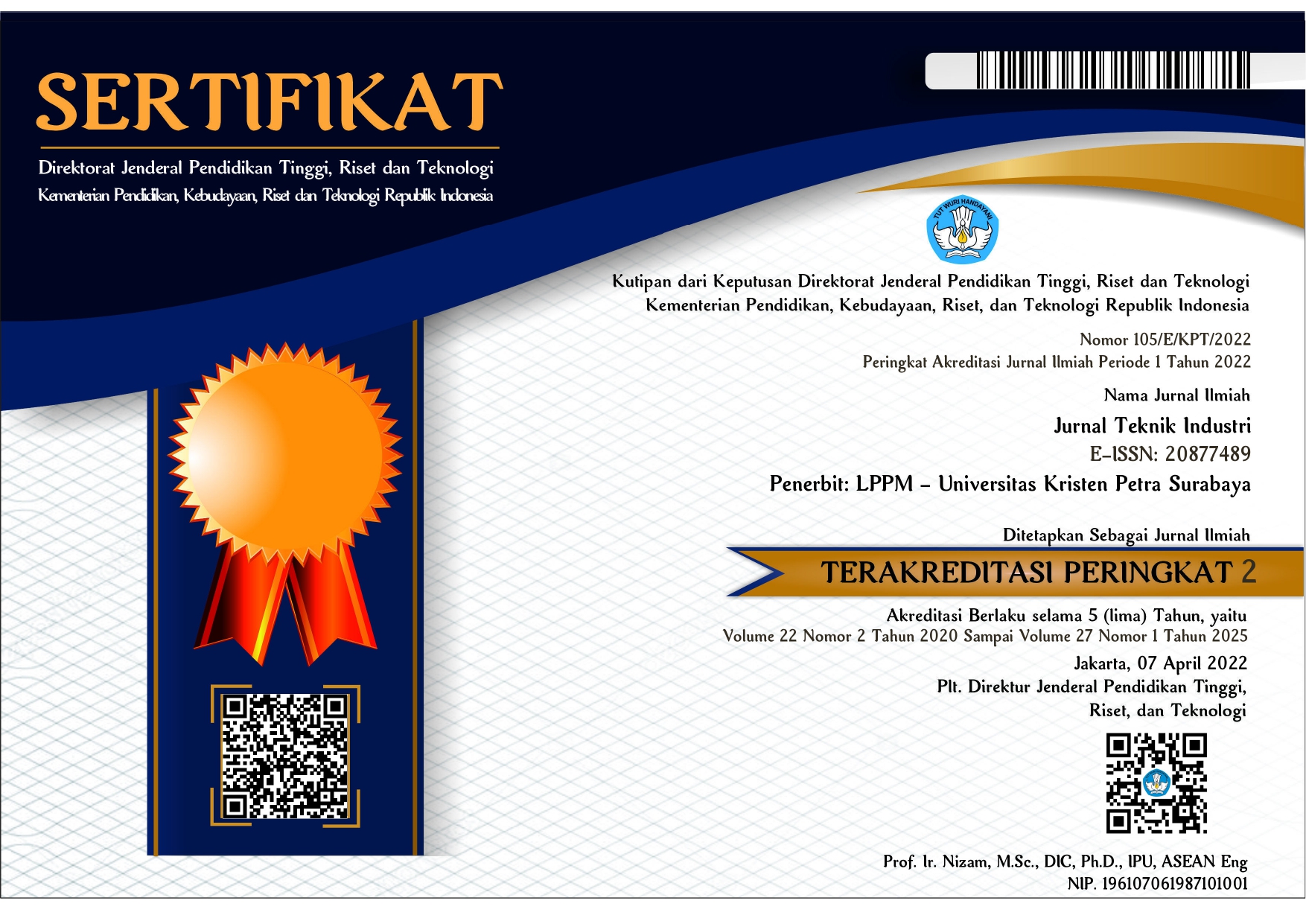Harmony Search for Balancing Two-sided Assembly Lines
DOI:
https://doi.org/10.9744/jti.14.2.83-88Keywords:
Harmony Search, Two-sided assembly lines, balancing.Abstract
Two-sided assembly lines balancing problems are important problem for large-sized products such as cars and buses, in which, tasks operations can be performed in the two sides of the line. In this paper, Harmony Search algorithm is proposed to solve two-sided assembly lines balancing problems type-I (TALBP-I). The proposed method adopts the COMSOAL heuristic and specific features of TALBP in the Harmony operators – the harmony memory consideration, random selection and pitch adjustment – in order to maintain the local and global search. The proposed method is evaluated based on 6 benchmark problems that are commonly used in TALBP. The experiment results show that the proposed method work well and produces better solution than the heuristic method and genetic algorithm.Downloads
References
Arcus, A. L., COMSOAL: A Computer Method of Sequencing Operations for Assem¬bly Lines, International Journal of Production Research, 4, 1966, pp. 259-277.
Askin, R. G., and Standridge, C. R., Modeling and Analysis of Manufacturing Systems, John Wiley and Sons, Florida, 1993.
Bartholdi, J. J., Balancing Two-sided As¬sem¬¬bly Lines: A Case Study, Internatio¬nal Journal of Production Research, 31, 1993, pp. 2447-2461.
Boysen, N., Fliedner, M., and Scholl, A., A Classi¬fication of Assembly Line Balancing Problems, European Journal of Operational Research, 183, 2007, pp. 674-689.
Boysen, N., Fliedner, M., and Scholl, A., Assembly Line Balancing: Which Model to Use When?, International Journal of Pro¬duction Economics, 111, 2008, pp. 509-528.
Chutima, P., and Chimklai, P., Multi-Objective Two-sided Mixed-model Assem¬bly Line Balanc¬ing using Particle Swarm Optimization with Negative Knowledge, Computers & Industrial Engineering, 62(1), 2012, pp. 39-55.
Geem, Z. W., Kim, J. H., and Loganathan, G. V., A New Heuristic Optimization Algo¬rithm: Har¬mony Search, Simulation, 76, 2001, pp. 60-68.
Geem, Z. W., Lee, K. S., and Park, Y., Appli¬cation of Harmony Search to Vehicle Rout¬ing, American Journal of Applied Sciences, 2, 2005, pp. 1552-1557.
Geem, Z. W., Harmony Search Application in Industry, In B. Prasad (ed): Soft Com¬puting Applications in Industry, Springer-verlag, Berlin Heidelberg, 2008, pp. 117-134.
Gutjahr, A. L., and Nemhauser, G. L., An Algorithm for the Line Balancing Problem, Management Science, 11(2), 1964, pp. 308–315.
Kim, Y. K., Kim, Y., and Kim, Y. J., Two-sided Assembly Line Balancing: A Genetic Algorithm Approach, Production Planning & Control, 11, 2000, pp. 44-53.
Kim, Y. K., Song, W. S., and Kim, J. H., A Mathematical Model and a Genetic Algo¬rithm for Two-sided Assembly Line Balanc¬ing, Computers and Operations Research, 36, 2009, pp. 853-865.
Lee, T. O., Kim, Y., and Kim, Y. K., Two-sided Assembly Line Balancing to Maxi¬mize Work Relatedness and Slackness, Computer and Industrial Engineering, 40, 2001, pp. 273-292.
Özbakır, L., and Tapkan, P., Bee Colony Intelligence in Zone Constrained Two-sided Assembly Line Balancing Problem, Expert Systems with Applications, 38, 2011, pp. 11947-11957.
Özcan, U. u., Balancing Stochastic Two-sided Assembly Lines: A Chance-cons¬trained, Piecewise-linear, Mixed Integer Program and a Simulated Annealing Al¬gorithm, European Journal of Operational Research, 205, 2010, pp. 81-97.
Purnomo, H. D., Wee, H. M., and Rau, H., Two-sided Assembly Lines Balancing with Assign¬ment Restrictions, Mathematical and Computer Modeling, 2011, doi:10.1016/ j.mcm.2011.06.010.
Scholl, A., Fliedner, M., and Boysen, N., ABSALOM: Balancing Assembly Lines with Assignment Restrictions, European Journal of Operational Research, 200, 2010, pp. 688-701.
Simaria, A. S., and Vilarinho, P. M., 2-ANTBAL: An Ant Colony Optimization Algorithm for Balancing Two-sided Assem¬bly Lines, Com¬puters and Industrial Engineering, 56, 2009, pp. 489-506.
Downloads
Published
How to Cite
Issue
Section
License
Articles published in the Jurnal Teknik Industri: Jurnal Keilmuan dan Aplikasi Teknik Industri will be Open-Access articles distributed under the terms and conditions of the Creative Commons Attribution License (CC BY).
![]()
This work is licensed under a Creative Commons Attribution License (CC BY).


















